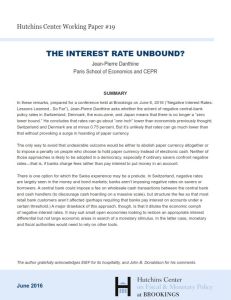Melden Sie sich bei getAbstract an, um die Zusammenfassung zu erhalten.

Melden Sie sich bei getAbstract an, um die Zusammenfassung zu erhalten.
Jean-Pierre Danthine
The Interest Rate Unbound?
Brookings Institution, 2016
Was ist drin?
How much below zero could interest rates go? And could negative rates put an end to paper money?
Recommendation
Negative real interest rates, although they sound counterintuitive, have existed at various times in history. Recently, central banks in Switzerland, Denmark, Sweden, Japan and the euro zone have adopted such policies either to manage exchange rates or to provide stimulus in today’s low-growth environment. Economist Jean-Pierre Danthine examines the impacts of such policies. Although his paper is rather technical and would have benefited from editing for clarity, it provides some good nuggets of information about negative rates’ impacts on society. getAbstract suggests Danthine’s eye-opening report to investors, policy makers and executives.
Summary
About the Author
Jean-Pierre Danthine is president of the Paris School of Economics.






















Comment on this summary